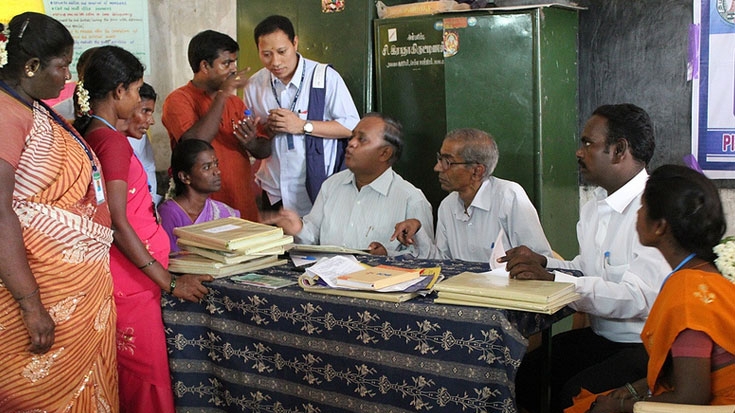South-South Knowledge Exchange
In September 2013, Indonesian government officials travelled to various parts of South Asia, as part of a study-tour to see how community-driven development programs in South Asia are enhancing livelihoods and improving access to finance. In India, the delegation visited the Pudhu Vaazhu Program in Tamil Nadu, the Jeevika Program in Bihar, the Indira Kranthi Patham Program in Andhra Pradesh. In Nepal, they visited the Poverty Alleviation Fund.
All four programs aim to encourage women to actively participate in improving the economic livelihood of their families by joining community organizations.
The study group got first-hand experience of how these projects have strengthened the capacity of poorest households by building institutions and providing a complete menu of facilitation and assistance.“It was useful to see how these programs start with community institutional strengthening at a very micro level, specifically, the women’s self-help groups; and how the community institutions are established and allowed to develop organically to a higher level,” said Pamuji Lestari, the Assistant Deputy for Community Empowerment, from Indonesia’s Coordinating Ministry for People’s Welfare.
Financial Inclusion and Enhanced Livelihoods
The success of these programs is heavily dependent on their ability to target the poorest and marginalized sections of the society, an area of particular interest to the Indonesian delegation, and to then organize them into a platform of community institutions. It all starts with organizing the target beneficiaries into community groups, and equipping them with both skills and resources. First, community mobilizers help in establishing and strengthening the women’s groups. Women are then encouraged to save regularly and lend to each other within the group, facilitated by village-level cadres trained by the project.
As the groups mature, they are organized into a village-wide organization, and given seed funds for internal lending to members. A formal relationship is then established between the women’s groups and nearby government or commercial banks, so that the business can access more credit and expand.
The banks do not require the groups to pledge any physical or financial collateral, but focus instead on demonstrated and documented competence in regular reporting of returns in the rolling funds of the women’s groups, the minutes of monthly meetings, and progress of members’ enterprises; Group strength is taken as collateral.
Lastly, community representatives help the women identify activities that they regard as priorities, and this may include household-level income-generating ventures, or group-based initiatives that provide jobs.
Social Empowerment
The groups also serve also as a platform to improve the quality of life and address social ills, such as gambling, alcoholism etc.
“Since joining this group, we have been able to make life better for our families. We have learned to read and write to help our children study, and now we have a voice to make our village better,” says Sabrina Katun, president of the village level federation in Seema village.
In addition, some of the community-driven programs also have a focus on bringing disabled people into mainstream. The participants got a chance to meet one such women in Tamil Nadu- Jayanthi, who is visually disabled. She had little hope of improving her livelihood before joining the program. However, after joining the program, she has worked hard to improve her skills and is now a professional trainer at a district level and has even completed a masters degree.
“I have been blind since birth, living in a faraway village. Now I am standing here speaking to you all. My dream is to get even more people like myself out of poverty so they can have a new hope,” says Jayanthi..
Lessons for Indonesia
Many of the findings from this study visit will serve as input for the government’s design of economic livelihood programs as part ofPNPM Mandiri.
According to Woro Srihastuti Sulistyaningrum, Head of the Sub-directorate for the Poor Community Empowerment, Poverty Alleviation Directorate of Bappenas, the Ministry wants to use the community-driven development program as one of the main platforms for poverty reduction and enhancing livelihoods in Indonesia – and visits such as this one to India are helping them formulate appropriate strategies.
That is enough reason for more ‘kolam’ paintings, in the spirit of striving for a better future.


